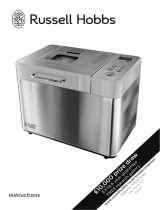
ingredients
T
he major ingredient in bread making is flour, so
selecting the right one is the key to a successful loaf.
wheat flours
W
heat flours make the best loaves. Wheat consists of
a
n outer husk, often referred to as bran, and an inner
kernel, which contains the wheat germ and
endosperm. It is the protein within the endosperm
which, when mixed with water, forms gluten. Gluten
stretches like elastic and the gases given off by the
yeast during fermentation are trapped, making the
dough rise.
white flours
These flours have the outer bran and wheat germ
removed, leaving the endosperm which is milled into
a white flour. It is essential to use strong white flour or
white bread flour, because this has a higher protein
level, necessary for gluten development. Do not use
plain white flour or self-raising flour for making yeast
risen breads in your bread maker, as inferior loaves
will be produced. There are several brands of white
bread flour available, use a good quality one,
preferably unbleached, for the best results.
wholemeal flours
Wholemeal flours include the bran and wheat germ,
which gives the flour a nutty flavour and produces a
coarser textured bread. Again strong wholemeal or
wholemeal bread flour must be used. Loaves made
with 100% wholemeal flour will be more dense than
white loaves. The bran present in the flour inhibits the
release of gluten, so wholemeal doughs rise more
slowly. Use the special wholewheat programs to allow
time for the bread to rise. For a lighter loaf, replace
part of the wholemeal flour with white bread flour. You
can make a quick wholemeal loaf using the rapid
whole wheat setting.
strong brown flour
This can be used in combination with white flour, or
on its own. It contains about 80-90% of the wheat
kernel and so it produces a lighter loaf, which is still
full of flavour. Try using this flour on the basic white
cycle, replacing 50% of the strong white flour with
strong brown flour. You may need to add a little extra
liquid.
g
ranary bread flour
A combination of white, wholemeal and rye flours
mixed with malted whole wheat grains, which adds
b
oth texture and flavour. Use on its own or in
combination with strong white flour.
non-wheat flours
Other flours such as rye can be used with white and
w
holemeal bread flours to make traditional breads like
pumpernickel or rye bread. Adding even a small
amount adds a distinctive tang. Do not use on its
own, as it will produce a sticky dough, which will
produce a dense heavy loaf. Other grains such as
millet, barley, buckwheat, cornmeal and oatmeal are
low in protein and therefore do not develop sufficient
gluten to produce a traditional loaf.
These flours can be used successfully in small
quantities. Try replacing 10-20% of white bread flour
with any of these alternatives.
salt
A small quantity of salt is essential in bread making
for dough development and flavour. Use fine table salt
or sea salt, not coarsely ground salt which is best
kept for sprinkling on top of hand-shaped rolls, to
give a crunchy texture. Low-salt substitutes are best
avoided as most do not contain sodium.
●
Salt strengthens the gluten structure and makes
the dough more elastic.
●
Salt inhibits yeast growth to prevent over-rising and
stops the dough collapsing.
●
Too much salt will prevent the dough rising
sufficiently.
sweeteners
Use white or brown sugars, honey, malt extract,
golden syrup, maple syrup, molasses or treacle.
●
Sugar and liquid sweeteners contribute to the
colour of bread, helping to add a golden finish to
the crust.
●
Sugar attracts moisture, so improving the keeping
qualities.
●
Sugar provides food for the yeast, although not
essential, as modern types of dried yeast are able
to feed on the natural sugars and starches found in
the flour, it will make the dough more active.
●
Sweet breads have a moderate level of sugar with
the fruit, glaze or icing adding extra sweetness.
Use the sweet bread cycle for these breads.
●
If substituting a liquid sweetener for sugar then the
total liquid content of the recipe will need to be
reduced slightly.
15




















